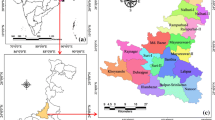The sustainable development and management of groundwater resource requires precise quantitative assessment based on scientific principle and modern techniques. In the present study, groundwater potential zone are delineated using remote sensing, geographical information system (GIS) and multi-criteria decision making (MCDM) techniques in Unnao district, Uttar Pradesh. The analytical network process (ANP) is a method that makes it possible for one to deal systematically, and includes the analytical hierarchy process (AHP) as a special case. The AHP and ANP are used to determine the weights of various themes and their classes for identifying the groundwater potential zone. These weights are applied in a linear combination to obtain five different groundwater potential zone in the study area, namely ‘very poor’, ‘poor’, ‘moderate’, ‘good’ and ‘very good’. It has been concluded that about 153.39 km2 area has very good groundwater potential which is only 3.37% of the total study area. However, the area having very poor groundwater potential is about 850 km2 which is about 19.63% of the study area. The area having good, moderate and poor groundwater potential is about 540.25, 1135.5, 1868.6 km2, respectively. The groundwater potential zone map was finally verified using the well yield data of 37 pumping wells, and the result was found satisfactory.







Similar content being viewed by others
References
Banai R 2010 Evaluation of land use – transportation systems with the analytic network process; Journal of Transport and Land Use 3(1) 85–112.
Cheng E W L and Li H 2004 Contractor selection using the analytic network process; Construction Management and Economics 22 1021–1032.
Chowdhury A, Jha M K, Chowdhary V M and Mal B C 2009 Integrated remote sensing and GIS-based approach for accessing groundwater potential in west Medinipur district, West Bengal, India; Int. J. Remote Sens. 30(1) 231–250.
Dagdeviren M and Ihsan Y 2007 Personnel selection using analytic network process; Istanbul Ticaret Üniversitesi Fen Bilimleri Dergisi Yil 6(11) 99–118.
Jaiswal R, Mukherjee S, Krishnamurthy J and Saxena R 2003 Role of remote sensing and GIS techniques for generation of groundwater prospect zone towards rural development – an approach; Int. J. Remote Sens. 24(5) 993–108.
Krishnamurthy J, Kumar N V, Jayaraman V and Manivel M 1996 An approach to demarcate groundwater potential zone through remote sensing and a geographic information system; Int. J. Remote Sens. 17(10) 1867– 1884.
Machiwal D, Jha M K and Mal B C 2011 Assessment of groundwater potential in a semi-arid region of India using remote sensing, GIS and MCDM techniques; J. Water Resourc. Manag. 25(5) 1359–1386.
Malczewski J 1999 GIS and multicriteria decision analysis (New York: John Wiley & Sons), 392p.
MOWR 2009 Report of the Groundwater Resource Estimation Committee; Ministry of Water Resources, Government of India, New Delhi, http://www.cgwb.gov.in.
Saaty T L 1980 The Analytic Hierarchy Process; McGraw-Hill, New York, NY.
Saaty T L 1996 Decision making with dependence and feedback, The Analytic Network Process; RWS Publications, Pittsburgh.
Saaty T L 1999 Fundamentals of the analytic network process; International Symposium of the Analytic Hierarchy Process (ISAHP), Kobe, Japan.
Saaty T L 2004 Fundamentals of the analytic network process – multiple networks with benefits, costs, opportunities and risks; J. Systems Science and Systems Engineering 13(3) 348–379.
Sun H, Xu G and Tian P 2007 Design alternatives evaluation of emergency bridge by applying analytic network process (ANP); System Engineering Theory and Practice 27(3) 63–70.
Tran L T, Knight C G, O’Neill R V and Smith E R 2004 Integrated environmental assessment of the Mid-Atlantic Region with Analytical Network Process; Environmental Monitoring and Assessment, Kluwer Academic Publishers 94 263–277.
Wang Ru-Hang, Huang Jian-Guo and Zhang Qun-Fei 2009 Underwater multiple target tracking decision making based on an analytic network process; Journal of Marine Science Application 8(4) 305–310.
Yang C L, Chuang S P, Huang R H and Tai C C 2008 Location selection based on AHP/ANP approach; IEEE, International Conference on Industrial Engineering and Engineering Management, Singapore, pp. 1148–1153.
Author information
Authors and Affiliations
Corresponding author
Rights and permissions
About this article
Cite this article
AGARWAL, E., AGARWAL, R., GARG, R.D. et al. Delineation of groundwater potential zone: An AHP/ANP approach. J Earth Syst Sci 122, 887–898 (2013). https://doi.org/10.1007/s12040-013-0309-8
Received:
Revised:
Accepted:
Published:
Issue Date:
DOI: https://doi.org/10.1007/s12040-013-0309-8




